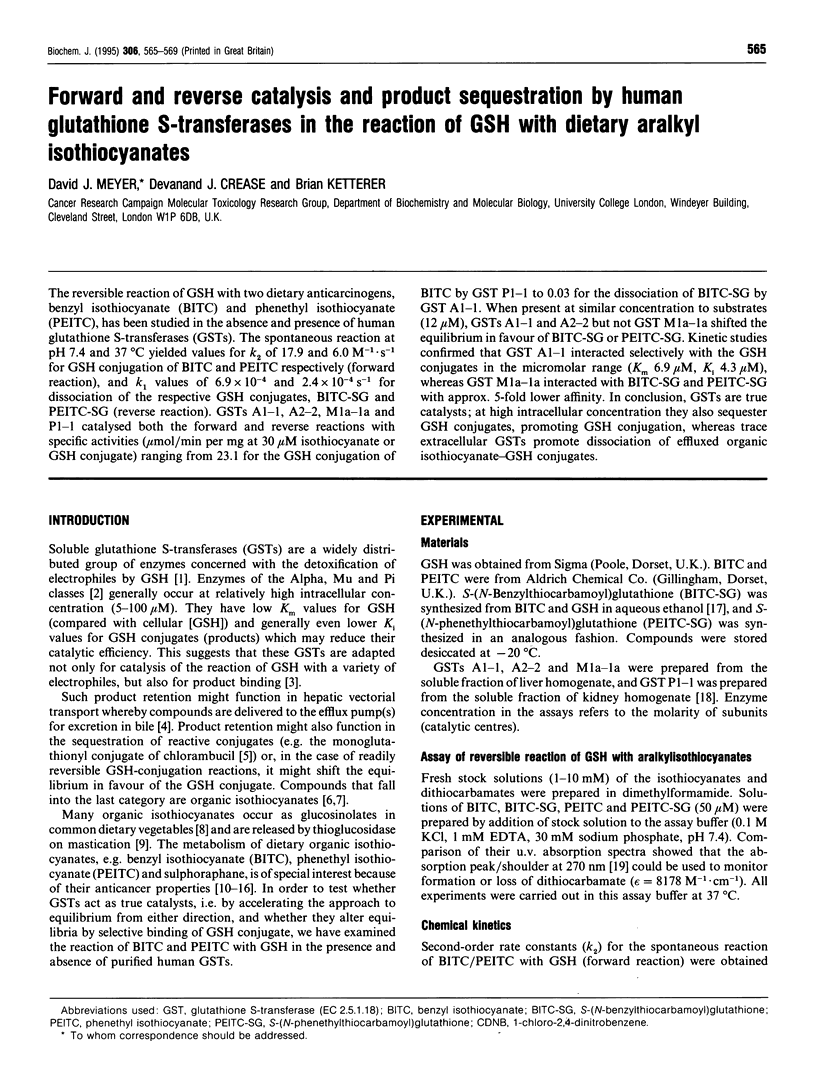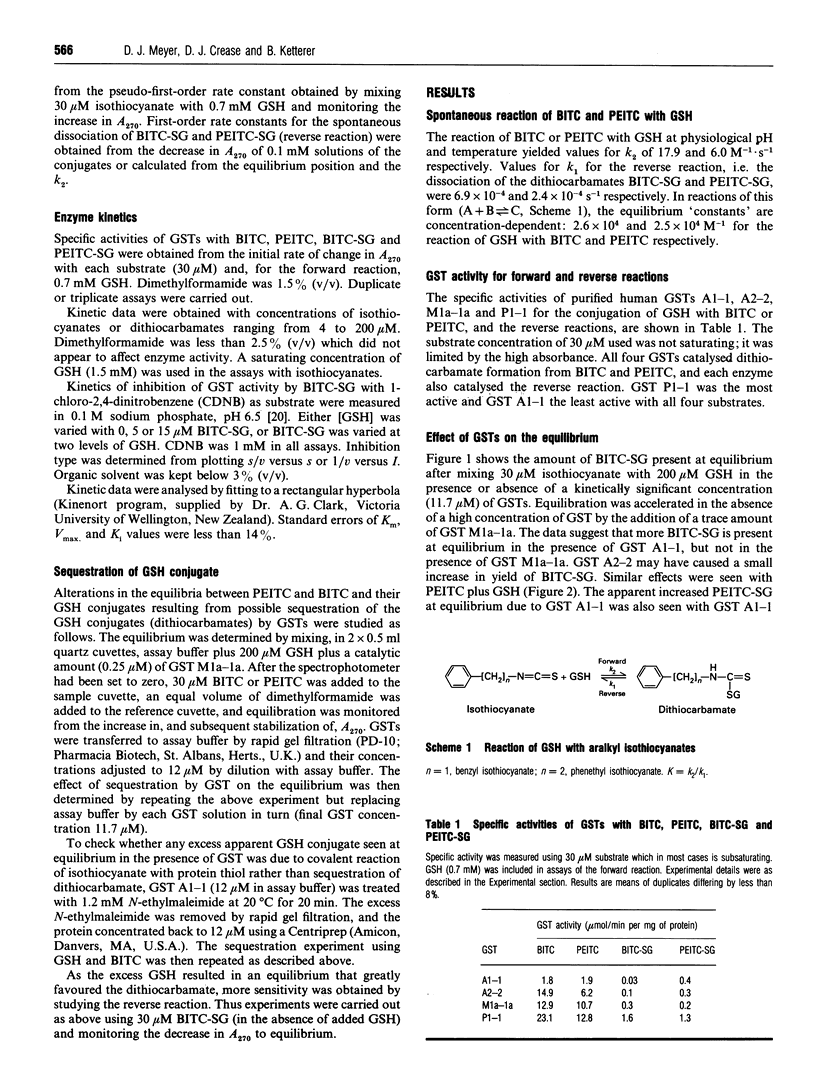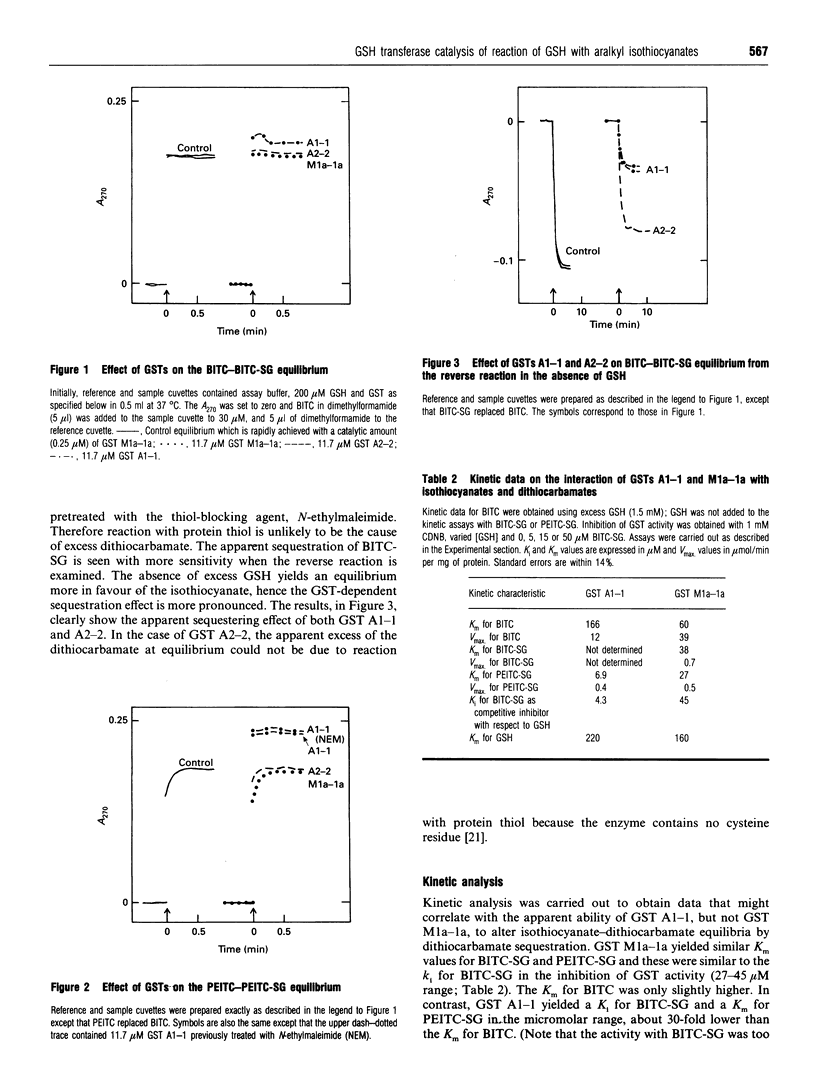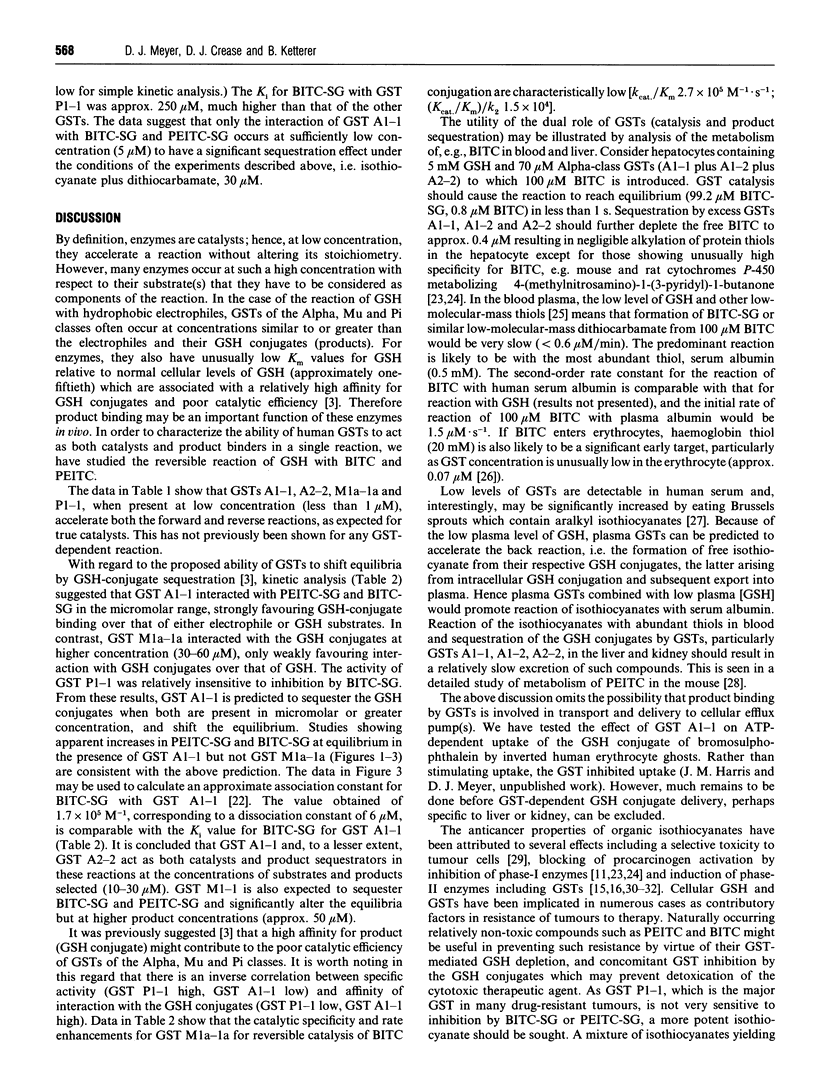Abstract
The reversible reaction of GSH with two dietary anticarcinogens, benzyl isothiocyanate (BITC) and phenethyl isothiocyanate (PEITC), has been studied in the absence and presence of human glutathione S-transferases (GSTs). The spontaneous reaction at pH 7.4 and 37 degrees C yielded values for k2 of 17.9 and 6.0 M-1.s-1 for GSH conjugation of BITC and PEITC respectively (forward reaction), and k1 values of 6.9 x 10(-4) and 2.4 x 10(-4) s-1 for dissociation of the respective GSH conjugates, BITC-SG and PEITC-SG (reverse reaction). GSTs A1-1, A2-2, M1a-1a and P1-1 catalysed both the forward and reverse reactions with specific activities (mumol/min per mg at 30 microM isothiocyanate or GSH conjugate) ranging from 23.1 for the GSH conjugation of BITC by GST P1-1 to 0.03 for the dissociation of BITC-SG by GST A1-1. When present at similar concentration to substrates (12 microM), GSTs A1-1 and A2-2 but not GST M1a-1a shifted the equilibrium in favour of BITC-SG or PEITC-SG. Kinetic studies confirmed that GST A1-1 interacted selectively with the GSH conjugates in the micromolar range (Km 6.9 microM, Ki 4.3 microM), whereas GST M1a-1a interacted with BITC-SG and PEITC-SG with approx. 5-fold lower affinity. In conclusion, GSTs are true catalysts; at high intracellular concentration they also sequester GSH conjugates, promoting GSH conjugation, whereas trace extracellular GSTs promote dissociation of effluxed organic isothiocyanate-GSH conjugates.
Full text
PDF




Selected References
These references are in PubMed. This may not be the complete list of references from this article.
- Awasthi Y. C., Singh S. V. Purification and characterization of a new form of glutathione S-transferase from human erythrocytes. Biochem Biophys Res Commun. 1984 Dec 28;125(3):1053–1060. doi: 10.1016/0006-291x(84)91390-1. [DOI] [PubMed] [Google Scholar]
- Baillie T. A., Kassahun K. Reversibility in glutathione-conjugate formation. Adv Pharmacol. 1994;27:163–181. doi: 10.1016/s1054-3589(08)61032-7. [DOI] [PubMed] [Google Scholar]
- Benson A. M., Barretto P. B. Effects of disulfiram, diethyldithiocarbamate, bisethylxanthogen, and benzyl isothiocyanate on glutathione transferase activities in mouse organs. Cancer Res. 1985 Sep;45(9):4219–4223. [PubMed] [Google Scholar]
- Bogaards J. J., Verhagen H., Willems M. I., van Poppel G., van Bladeren P. J. Consumption of Brussels sprouts results in elevated alpha-class glutathione S-transferase levels in human blood plasma. Carcinogenesis. 1994 May;15(5):1073–1075. doi: 10.1093/carcin/15.5.1073. [DOI] [PubMed] [Google Scholar]
- Brüsewitz G., Cameron B. D., Chasseaud L. F., Görler K., Hawkins D. R., Koch H., Mennicke W. H. The metabolism of benzyl isothiocyanate and its cysteine conjugate. Biochem J. 1977 Jan 15;162(1):99–107. doi: 10.1042/bj1620099. [DOI] [PMC free article] [PubMed] [Google Scholar]
- Eklind K. I., Morse M. A., Chung F. L. Distribution and metabolism of the natural anticarcinogen phenethyl isothiocyanate in A/J mice. Carcinogenesis. 1990 Nov;11(11):2033–2036. doi: 10.1093/carcin/11.11.2033. [DOI] [PubMed] [Google Scholar]
- Fenwick G. R., Heaney R. K., Mullin W. J. Glucosinolates and their breakdown products in food and food plants. Crit Rev Food Sci Nutr. 1983;18(2):123–201. doi: 10.1080/10408398209527361. [DOI] [PubMed] [Google Scholar]
- Guo Z., Smith T. J., Wang E., Eklind K. I., Chung F. L., Yang C. S. Structure-activity relationships of arylalkyl isothiocyanates for the inhibition of 4-(methylnitrosamino)-1-(3-pyridyl)-1-butanone metabolism and the modulation of xenobiotic-metabolizing enzymes in rats and mice. Carcinogenesis. 1993 Jun;14(6):1167–1173. doi: 10.1093/carcin/14.6.1167. [DOI] [PubMed] [Google Scholar]
- Habig W. H., Pabst M. J., Jakoby W. B. Glutathione S-transferases. The first enzymatic step in mercapturic acid formation. J Biol Chem. 1974 Nov 25;249(22):7130–7139. [PubMed] [Google Scholar]
- Hasegawa T., Nishino H., Iwashima A. Isothiocyanates inhibit cell cycle progression of HeLa cells at G2/M phase. Anticancer Drugs. 1993 Apr;4(2):273–279. doi: 10.1097/00001813-199304000-00021. [DOI] [PubMed] [Google Scholar]
- Huang Q., Lawson T. A., Chung F. L., Morris C. R., Mervish S. S. Inhibition by phenylethyl and phenylhexyl isothiocyanate of metabolism of and DNA methylation by N-nitrosomethylamylamine in rats. Carcinogenesis. 1993 Apr;14(4):749–754. doi: 10.1093/carcin/14.4.749. [DOI] [PubMed] [Google Scholar]
- Ketterer B., Christodoulides L. G. Enzymology of cytosolic glutathione S-transferases. Adv Pharmacol. 1994;27:37–69. doi: 10.1016/s1054-3589(08)61029-7. [DOI] [PubMed] [Google Scholar]
- LeBlanc G. A. Hepatic vectorial transport of xenobiotics. Chem Biol Interact. 1994 Feb;90(2):101–120. doi: 10.1016/0009-2797(94)90097-3. [DOI] [PubMed] [Google Scholar]
- Mannervik B., Awasthi Y. C., Board P. G., Hayes J. D., Di Ilio C., Ketterer B., Listowsky I., Morgenstern R., Muramatsu M., Pearson W. R. Nomenclature for human glutathione transferases. Biochem J. 1992 Feb 15;282(Pt 1):305–306. doi: 10.1042/bj2820305. [DOI] [PMC free article] [PubMed] [Google Scholar]
- Mansoor M. A., Svardal A. M., Ueland P. M. Determination of the in vivo redox status of cysteine, cysteinylglycine, homocysteine, and glutathione in human plasma. Anal Biochem. 1992 Feb 1;200(2):218–229. doi: 10.1016/0003-2697(92)90456-h. [DOI] [PubMed] [Google Scholar]
- Meyer D. J., Gilmore K. S., Harris J. M., Hartley J. A., Ketterer B. Chlorambucil-monoglutathionyl conjugate is sequestered by human alpha class glutathione S-transferases. Br J Cancer. 1992 Sep;66(3):433–438. doi: 10.1038/bjc.1992.292. [DOI] [PMC free article] [PubMed] [Google Scholar]
- Meyer D. J. Significance of an unusually low Km for glutathione in glutathione transferases of the alpha, mu and pi classes. Xenobiotica. 1993 Aug;23(8):823–834. doi: 10.3109/00498259309059411. [DOI] [PubMed] [Google Scholar]
- Musk S. R., Johnson I. T. Allyl isothiocyanate is selectively toxic to transformed cells of the human colorectal tumour line HT29. Carcinogenesis. 1993 Oct;14(10):2079–2083. doi: 10.1093/carcin/14.10.2079. [DOI] [PubMed] [Google Scholar]
- Rhoads D. M., Zarlengo R. P., Tu C. P. The basic glutathione S-transferases from human livers are products of separate genes. Biochem Biophys Res Commun. 1987 May 29;145(1):474–481. doi: 10.1016/0006-291x(87)91345-3. [DOI] [PubMed] [Google Scholar]
- Smith T. J., Guo Z. Y., Thomas P. E., Chung F. L., Morse M. A., Elkind K., Yang C. S. Metabolism of 4-(methylnitrosamino)-1-(3-pyridyl)-1-butanone in mouse lung microsomes and its inhibition by isothiocyanates. Cancer Res. 1990 Nov 1;50(21):6817–6822. [PubMed] [Google Scholar]
- Smith T. J., Guo Z., Li C., Ning S. M., Thomas P. E., Yang C. S. Mechanisms of inhibition of 4-(methylnitrosamino)-1-(3-pyridyl)-1-butanone bioactivation in mouse by dietary phenethyl isothiocyanate. Cancer Res. 1993 Jul 15;53(14):3276–3282. [PubMed] [Google Scholar]
- Sparnins V. L., Chuan J., Wattenberg L. W. Enhancement of glutathione S-transferase activity of the esophagus by phenols, lactones, and benzyl isothiocyanate. Cancer Res. 1982 Apr;42(4):1205–1207. [PubMed] [Google Scholar]
- Sugie S., Yoshimi N., Okumara A., Tanaka T., Mori H. Modifying effects of benzyl isothiocyanate and benzyl thiocyanate on DNA synthesis in primary cultures of rat hepatocytes. Carcinogenesis. 1993 Feb;14(2):281–283. doi: 10.1093/carcin/14.2.281. [DOI] [PubMed] [Google Scholar]
- Vos R. M., Snoek M. C., van Berkel W. J., Müller F., van Bladeren P. J. Differential induction of rat hepatic glutathione S-transferase isoenzymes by hexachlorobenzene and benzyl isothiocyanate. Comparison with induction by phenobarbital and 3-methylcholanthrene. Biochem Pharmacol. 1988 Mar 15;37(6):1077–1082. doi: 10.1016/0006-2952(88)90513-8. [DOI] [PubMed] [Google Scholar]
- Wattenberg L. W. Inhibitory effects of benzyl isothiocyanate administered shortly before diethylnitrosamine or benzo[a]pyrene on pulmonary and forestomach neoplasia in A/J mice. Carcinogenesis. 1987 Dec;8(12):1971–1973. doi: 10.1093/carcin/8.12.1971. [DOI] [PubMed] [Google Scholar]
- Zhang Y., Kensler T. W., Cho C. G., Posner G. H., Talalay P. Anticarcinogenic activities of sulforaphane and structurally related synthetic norbornyl isothiocyanates. Proc Natl Acad Sci U S A. 1994 Apr 12;91(8):3147–3150. doi: 10.1073/pnas.91.8.3147. [DOI] [PMC free article] [PubMed] [Google Scholar]


